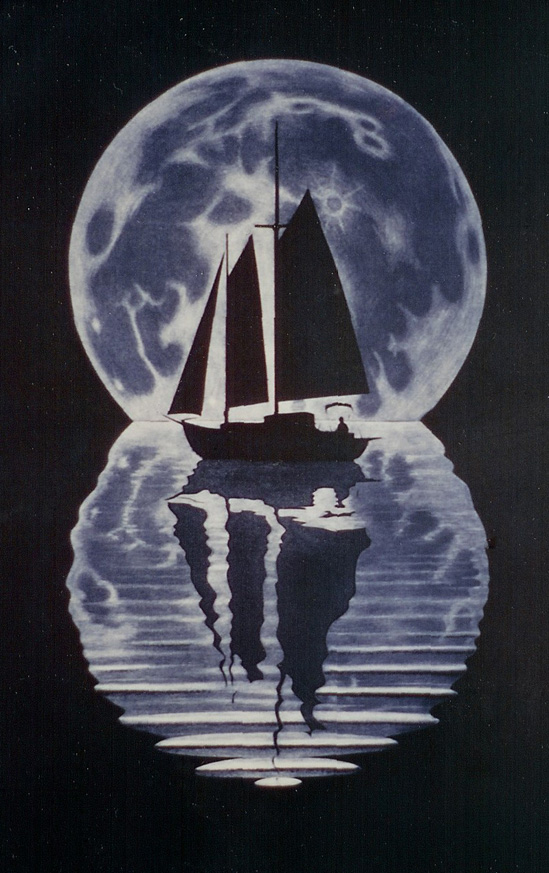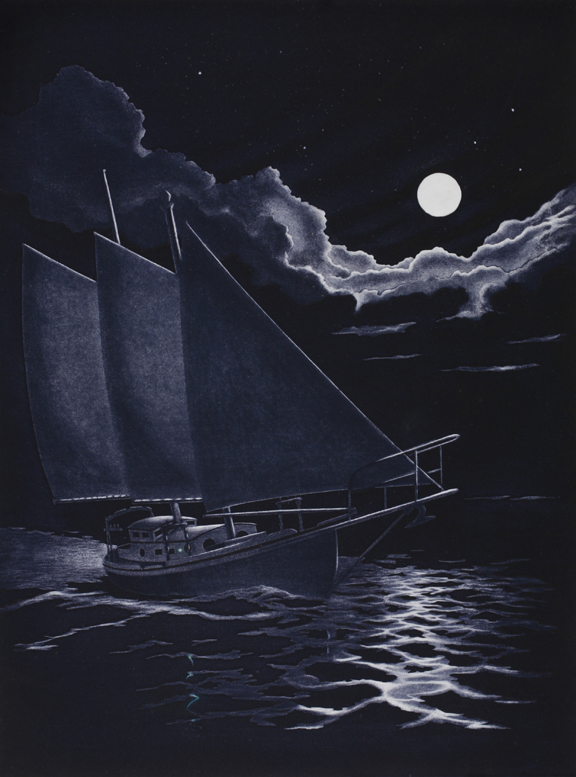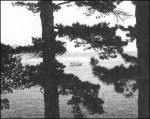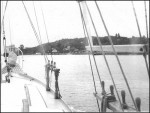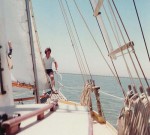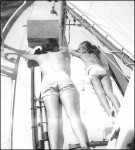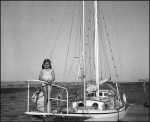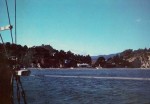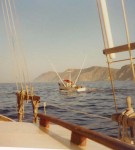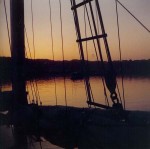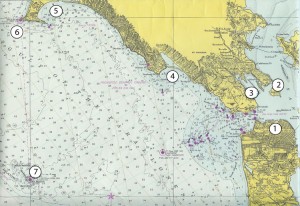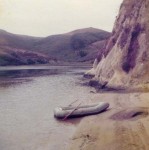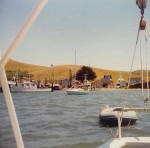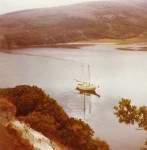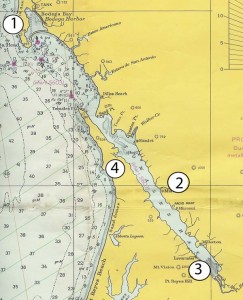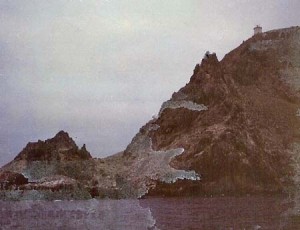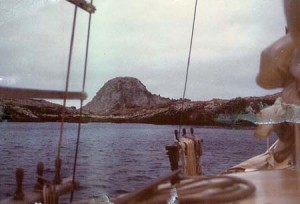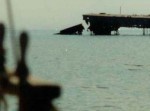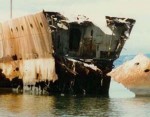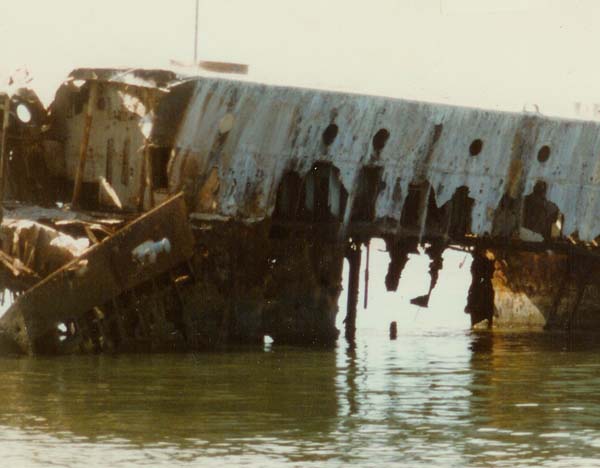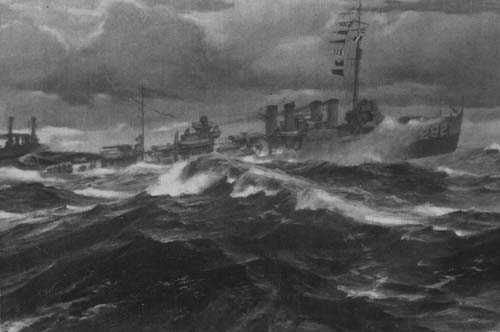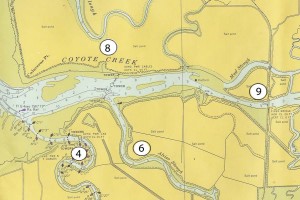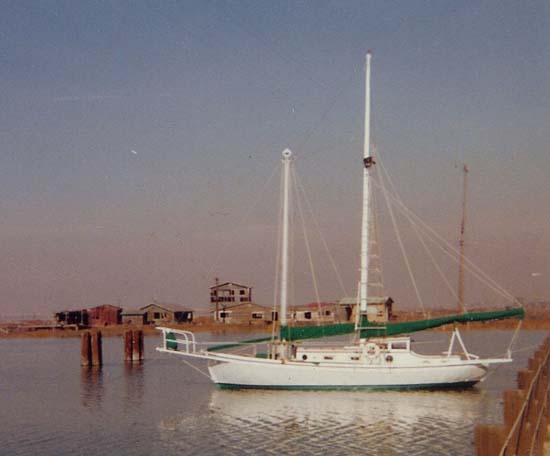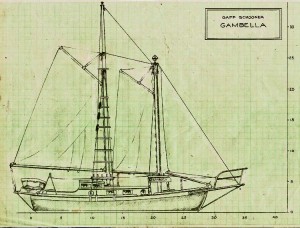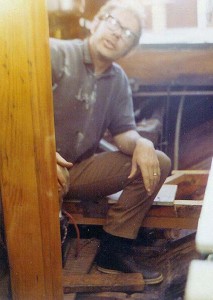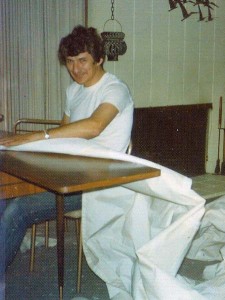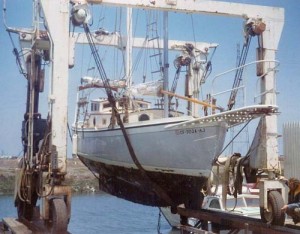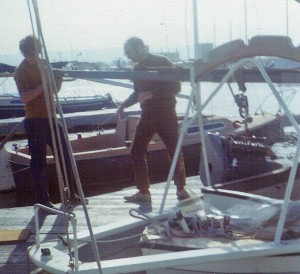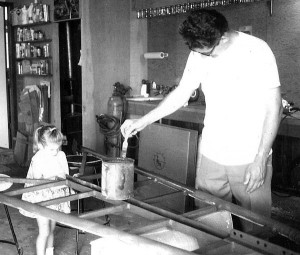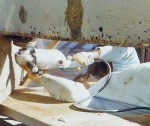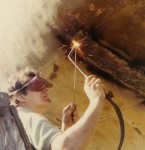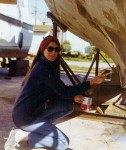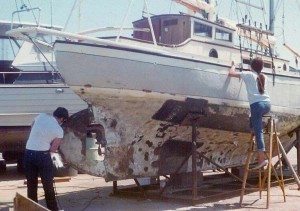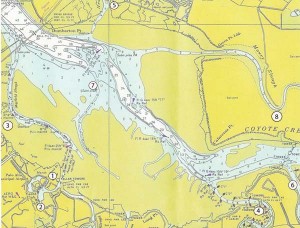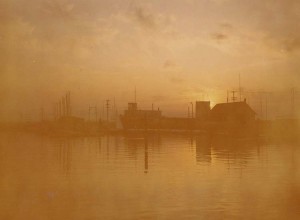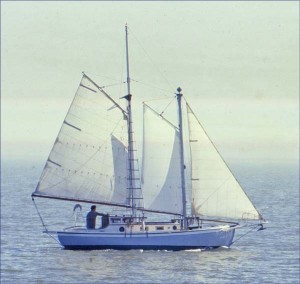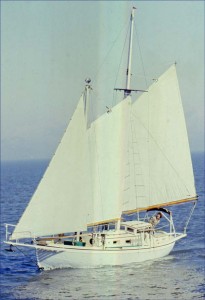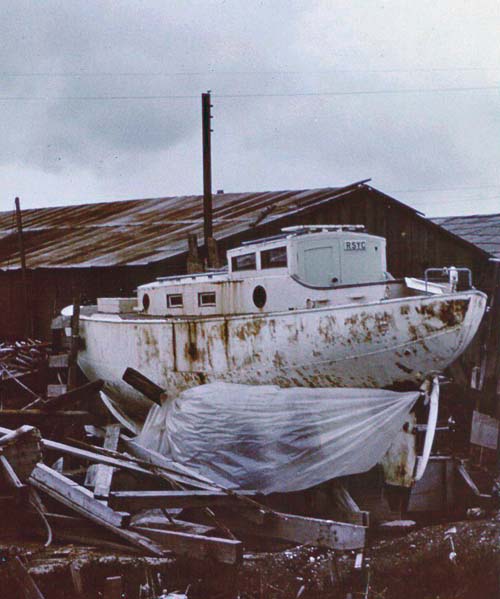GAMBELLA
6. GAMBELLA Forever
During the years that I spent working as an engineer I could afford to own a boat like the GAMBELLA, but somewhere around 1980 I decided to take a stab at being an artist. I always had some native ability in that area and I wanted to give it a try as a living. Working as a professional artist is all about creativity and a lot more fun than working as an engineer. Engineering, at least in the manner in which I was employed, was quite uncreative work. It was, however, much more lucrative. Consequently, I sold my boat to help finance my conversion from engineer to artist.
Having spent so many years restoring, maintaining and sailing the GAMBELLA, I was intimately familiar with every inch of her, and to this day I can still come up with a decent rendering of her various aspects strictly from memory. She had become engrained in my being and reflected my personality to a high degree, perhaps even to a fault. It is not surprising, therefore, that she should appear in various works of art that I was to accomplish. Anyone who explores Uncle Rob’s Blog to any extent is bound to encounter many images of the GAMBELLA. The following image has been in use as my logo on business cards and letterheads for quite some time:
Looking back from the perspective of many years, and from the point of view of an artist, I can now see the GAMBELLA was a work of art. She was the creative outlet I needed to balance my rather mundane employment, and just as an artist’s work is always his or her work even it if is subsequently sold, she is still mine in that respect.
I think the following image and poem express my feelings adequately:
Moon Ship
It was a warm summer night and the schooner GAMBELLA stretched her pretty legs. Countless hours of my personal attention were paying dividends as she moved south with a nimble grace. The Bay was smooth and flat. The tide was on the flood and a gentle breeze was steady over the port quarter. Then a full Moon rose over the East Bay hills and its muted light danced on the surface of the water.
Oh, to linger in that reflection,
A brief passage of near perfection.
Dream-like it was, but alas it was real.
It needed some water under the keel.
I knew we were running out of bay,
But didn’t want it to end that way.
I made an image to hang on my wall,
And in it GAMBELLA still stands tall.
The hiss of the wake’s trailing froth,
The creak of the rig working aloft,
These things I hear when I can see
The rare moment that transported me.
So when life’s voyage comes to an end
I’d make that passage once again.
And if to heaven I have gone
There I’ll sail her on and on.
R. L. Mason
Mendocino, CA
2009
5. . . . and Yon
Up and Down the Bay
Having thoroughly explored the South Bay we started to venture further afield. There were numerous excursions to destinations such as San Francisco, Sausalito, Angel Island, Yerba Buena Cove, and one memorable trip up the Petaluma River.
(click on image for larger view)
And Out the Gate
Eventually, we left the Bay entirely, usually proceeding north along the coast to destinations such as Bolinas Bay and Drake’s Bay. Each trip found us going further afield. We rounded Pt. Reyes and ended up in Bodega Harbor with
its substantial commercial fishing fleet. But our favorite destination was Tomales Bay which is directly south across Bodega Bay from Bodega Harbor. The distance is about ten miles.
Points of Interest: (click on image for larger view)
(1) San Francisco
(2) Angel Island
(3) Sausalito
(4) Bolinas Bay (also click here)
(5) Drake’s Bay
(6) Point Reyes
(7) The Farallon Islands
The best time to enter Tomales Bay is in the morning at high tide before the wind picks up. The entrance is fairly shallow and sometimes the combination of an ebb tide and the Northwest wind can made it extremely rough. The Bay itself is long and narrow and it has this shape because it sits right on top of, and is formed by, the San Andreas Fault. At the foot of the Bay is Inverness where you can pick up groceries, gas etc. On the east shore, at about the half way point, is the town Marshall which has a boat works should you need one. Approximately across from Marshall and a little to the north is White Gulch — my favorite anchorage.
(click on image for larger view)
Points of Interest:
(1) Bodega Harbor
(2) Marshall (also click here)
(3) Inverness (also click here)
(4) White Gulch (also click here)
The winds for sailing on Tomales Bay are rather flukey. They change every time you pass by a low gap in the Tomales Peninsula, but the scenery is superb. The resident human population is very low and the surroundings are primarily bucolic. On the peninsula there is a population of elk.
The Farallon Islands
On two occasions I visited the Farallon Islands. The largest island has an anchorage on the north side called Fisherman’s Cove. It is only big enough for one boat (maybe two) to swing at anchor and is only an alternative in fairly calm weather. The bottom of the cove is composed of large boulders and crevasses, and I had heard it was a very easy place to lose an anchor. I stopped there once for an overnight on a return trip from the Bodega area, and I didn’t get much sleep. Immediately upon arriving, the boat was covered with a swarm of flies. Fortunately, I had a can of bug spray to discourage them, but I had to use the whole can. The cove is surrounded by lounging sea lions and at the slightest disturbance there would arise rounds and rounds of barking. There is usually a naturalist stationed on the island, and I could see one watching my every move when I arrived, but since I made no attempt to go ashore, which is prohibited, he eventually lost interest. That occasion and the following day turned out to be a very wet trip, so the only photos I have are water damaged, but here they are for what they are worth:
(click on image for larger view)
4. Thither . . .
DD 305
Here is a sight in the South San Francisco Bay that can only be seen up close by boat. It is about three miles north of the Dumbarton Bridge on the east side of the Bay. It is almost directly east of the entrance to the Port of Redwood City. These photos are 35 to 40 years old so maybe not as much can be seen today:
(click on image for larger view)
What is seen is what remains of the USS Thompson (DD 305). She has been at this location since 1944, and is the last of the “Four Pipers.” She was commissioned at the Mare Island Navy Yard in August 1920, a little late for an active part in WWI. She was one of 273 flush-deck destroyers commissioned between 1917 and 1922. By WWII they were approaching obsolescence but still managed to play a role in that conflict. The Thompson was sold in June of 1931 and at one point served as a bar in South San Francisco, but during WWII she was scuttled at her present location and used as a target for pilots training at nearby Moffett Field Naval Air Station.
Here is a depiction of what she would have looked like in action:
Drawbridge
In the previous post I mentioned points of interest that can be seen by sailing south from Palo Alto, but there is one more in that direction that should be noted that is of historical significance. It is called Drawbridge and is located about as far as one can go by boat at the south end of San Francisco Bay. Today it is a ghost town but in the 1920s it was a thriving little village. The chart below shows it’s location (9):
(click on image for larger view)
Points of Interest:
(4) Guadalupe Slough
(6) Alviso Slough
(8) Abandoned Duck Club up Mowry Slough
(9) Drawbridge
The history of Drawbridge starts with the building of a railroad line across Station Island in about 1876. Station Island is formed by Warm Springs Slough (now called Mud Slough) on the north side and Coyote Slough (0r Creek) on the south side. Both of these waterways were navigable and thus required by federal law to remain open. Consequently, the railroad had to provide a drawbridge at each slough and hire someone to operate them. This was done, and somewhere in the mid 1870s a shack was built to house the drawbridge operator. Word spread that the area was excellent for duck hunting and fishing. Soon, other shacks were built along the railroad tracks and a whole village sprang into existence. During prohibition the “town” was very popular because the only way to get to it was by boat or railroad, a fact which insulated it from local law enforcement. To this day access is still quite limited. You can hike out along the railroad tracks north from Alviso for about two miles or arrive by boat. Below is a photo of the GAMBELLA moored Mediterranean style to the railroad trestle in about 1980:
2. Sinking Beer Cans
In the early 1960s I joined Uncle Sam’s Yacht Club and spent four years on active duty. Toward the end of that tour of duty I married Lynne Harley and after I left the Navy we purchased a 31 foot sloop named ESCAPE, but that’s another story. In the meantime Doug purchased the GAMBELLA and began the long process of restoration. To his credit, Doug managed to get her back in the water and functioning again. Lynne and I worked on the ESCAPE and sailed her here and there, mostly within the San Francisco Bay Area. After a couple of years of sailing the ESCAPE we sold it and were without a boat for a while.
About that same time Doug had become somewhat discouraged with the enormous task of restoring the GAMBELLA, and I was missing a nautical element to my life. After some discussion the three of us, Doug, his brother Stan and I decided to form a partnership and continue the GAMBELLA project. We normally spent one day a week (usually Saturday) working on our boat. After a short period of time Stan dropped out of the project, but Doug and I continued on for several years before I bought his share.
Typically, we would meet at the boat Saturday morning with a six-pack of beer. We would have our first beer which we called our “think drink” while planning the day’s work. After working through the morning we would have our second beer with our lunch, and the last beer after finishing up for the day. We used a marlin spike to punch holes in the cans and then tossed them overboard to sink. I liked to think of this as recycling because while going to college I worked summers for W.P. Fuller & Co. in their plant right on the edge of the Bay in South San Francisco. Next door to the plant was another industrial operation that extracted dissolved aluminum from sea water. Doug, on the other hand, being a math major, tried to determine the minimum number of holes and their placement that would be required to insure that the can would always sink.
As fate would have it, Doug and I both ended up working for Matson Navigation Co. in their industrial engineering department, and this gave us the opportunity to plan our Saturday efforts in great detail on company time. Here is the sail plan that we decided upon:
(click on image for larger view)
The original rig of the GAMBELLA was probably that of a cutter with bowsprint and double head sails. As rigged by Doug it became a sloop with a single head sail and no bowsprint. However, based on our experience with the LA BAÑERA we decided on a gaff rigged schooner — it’s such a salty rig. The existing mainmast was shortened and moved aft and a new foremast was stepped where the main had been. The following pictures should give an inkling of the scope of work involved in the refit:
(click on images for larger view)
3. Hither, . . .
As indicated in the previous post, by the mid-seventies the refitting of the GAMBELLA was pretty much complete, and at that point we started sailing more while work tapered off somewhat. Initially, we poked into all the nooks and crannies of the South Bay. There are some interesting historical aspects to that general area, and also some sights that can only be appreciated or, at least, are best appreciated by boat. It should be noted, however, that getting to most of them requires close attention to the tides. Typically, an exploration must begin on a flood tide and end on an ebb tide. This will provide six to eight hours of sailing time. An alternative is to spend eight to twelve hours at the destination and return on the following tide. If you don’t follow this schedule you will probably end up stranded on the mud flats for hours. The tidal range in the South Bay is six to eight feet, about twice what it is at the Golden Gate Bridge. Consequently, at high tide there is plenty of water for sailing, whereas there are miles of mud flats at low tide. So, when studying the chart below, it should be noted that almost all of the area that is colored light green is sailable at high tide.
The earliest literary reference I have found to the South Bay is in the book, Two Years Before the Mast, by Richard Henry Dana. Dana was a student at Harvard when he contracted a severe case of measles which adversely effected his general health. His doctor recommended a sea voyage to aid his recovery. So Dana signed on as a deck hand in a vessel that was engaged in the hide trade up and down the coast of California. That was around the year 1835, and his written account of this experience was the only book available in English that contained detailed descriptions of California at the time of gold rush. Consequently, he became rather famous and there are many places in California that now bear the name of Dana as a result.
Dana’s book includes an account of rowing down the bay in long boats to the missions of San Jose and Santa Clara to collect hides. It is most likely that the route to Mission Santa Clara was by way of Guadalupe Slough and the way to Mission San Jose was Alviso Slough (see points 4 & 6 on chart below). In the late 1970s I was up Guadalupe slough several times as far as a small fuel dock used for unloading barges laden with jet fuel bound for Moffett Field Naval Air Station. It was a great place to watch an air show, and thus avoid the traffic and crowds. Also, if correctly timed with respect to the tides, you could occasionally leave Palo Alto on a flood tide, run down the bay and up Alviso Slough to the town of Alviso, have dinner at a fine Italian restaurant, sail back up the bay on an ebb tide, and be in your berth before you ran out of water.
(click on image for larger view)
Points of interest:
(1) Palo Alto Yacht Harbor
(2) Old location of the Palo Alto Boat Works
(3) New location of The Palo Alto Boat Works
(4) Guadalupe Slough
(5) Newark Slough
(6) Alviso Slough
(7) Oyster shed remains
(8) Abandoned duck club
In another historical reference to the South Bay, Jack London mentions “oyster pirates” in several of his fictional works. In the late 1800s large corporate interests were raising oysters in the South Bay. When harvested, the oysters were dredged up off bottom and stored temporarily in oyster sheds which were on pilings in the off shore shallow waters. The pirates would come down the bay on a flood tide at night, rob the sheds, and then retreat north on the ebb tide. A young Jack London apparently took part in this venture in a boat he owned called the RAZZLE DAZZLE. When I first started sailing on the the South Bay, circa 1960, some of the pilings that had supported these sheds were still visible at low tide (see point 7 on the chart above).
(click on images for larger view)
Palo Alto Yacht Harbor was always home base in those days (see point 1 on the chart above), but there were several nearby spots that were popular for overnight getaways. Almost directly across the bay were Newark Slough and Mowry Slough, both of which were near the Leslie Salt processing plant, but in spite of this they seemed very remote from civilization (see points 5 & 8 on chart above).
On one occasion I was up Mowry Slough by myself for an overnight, and an exploration of the abandoned duck club that is some distance up the slough. The Slough is quite narrow there so I put out anchors both fore and aft to keep the boat aligned with what water remained at low tide. In the morning as I was preparing to leave, I pulled up the forward anchor and then backed under power to lift the stern anchor, and in the process I backed over the stern anchor line and wound it around the prop. After saying a few naughty words under my breath I went forward and reset the bow anchor. After that I sat in the cockpit for a few moments trying to decide what to do.
Mowry Slough is so situated that going up the Slough is almost directly down wind and conversely coming out of the Slough is almost directly up wind. Getting out of there without power was a very daunting task, and it seemed apparent to me that I was going to need the engine. There was only one thing to do; I stripped down and went overboard to try and free the stern anchor line from the prop. The water was so muddy that I couldn’t see anything and had to do the whole operation with only my sense of touch. After coming up for air a few times I did mange to get the whole mess untangled. I climbed back aboard, cleaned up and started the engine. However, when I put her in gear nothing happened. This time I said the naughty words out loud. Apparently, this little mishap had broken the drive shaft. Again, I sat in the cockpit for a while trying to decide what to do next.
It seemed obvious that I was going to have to sail her out of there, but by now it was too late as the tide was already too far gone, making maneuvering in the slough impossible. That meant about another twelve hours while I waited for the next high tide. It gave me plenty of time to think about just how I would go about doing this. A gaff rigged schooner is quite a handful for a single person to handle under the best of conditions. There are three sails, five halyards and three sheets that have to be tended to, and on top of that, in this instance, I also had to raise the bow anchor at the same time I was getting underway. But I had twelve hours to plan my every move in detail.
I also had my art supplies with me so, to pass the time, I did an ink wash rendering of the abandoned duck club. The club house was abandoned in 1968 when legislation created the San Francisco Bay National Wildlife Refuge. You could wander through the collapsing shacks in the 1970s and still see clothes hanging on wall hooks and cans of food on the shelves. Swallows had moved in and made themselves at home and everything was covered with their droppings. You may see my rendering (as an etching) of that site by clicking here.
Come the next high tide I had all my moves thoroughly choreographed in my mind. I hoisted all the sails, raised the anchor, then dashed aft to man the tiller. I tacked a whole series of short reaches and I did manage to sail her out of there, cross the bay and and enter my own slip all under sail, a feat of seamanship I still feel rather proud of today.
Secure in my own home berth I decided to open up the engine room and crawl back there to see the extent of the bad news. To my surprise the shaft was not broken, it had simply been pulled out of the spline at the back of the transmission. It was a relatively easy thing to fix, one that could have been done on the spot had I not assumed the worst.
1. The Early History
GAMBELLA: I believe this an Italian idiomatic expression that literally translates to “pretty legs” but in a nautical context means “good lines.”
Apparently she spent some time in Singapore and was a member of the Royal Singapore Yacht Club. If you look closely at the photo you can see that letters RSYC are still posted on the after buklhead of the cabin. I believe, while in Singapore, the dog house was added. It is made of teak and of entirely different construction than the rest of the boat. Also, somewhere along the line, the capability for inside steering was added in addition to a larger more powerful engine. At that point she essentially became a small motorsailer.
As I remember she was then sailed to Guam, but I don’t know how long she was there. Eventually, she was shipped aboard a freighter to the San Francisco Bay Area. I did hear a story from the owner of the Palo Alto Boat Works that at some point she hit a snag and sank in the shallow water of the South Bay. She was apparently raised and repaired from that adventure, but finally ended up in the old Palo Alto Boat Works where the picture above shows her. That picture dates to about 1961. About that time my buddy Doug, his brother Stan and I owned an old converted lifeboat which we called LA BAÑERA (The Bath Tub). We used to haul out at the old Palo Alto Boat Works right next to where the GAMBELLA was slowly rusting away, and this gave us the opportunity to give her a close look.
Here is what she looked like in the mid-seventies when restoration was more or less compete:
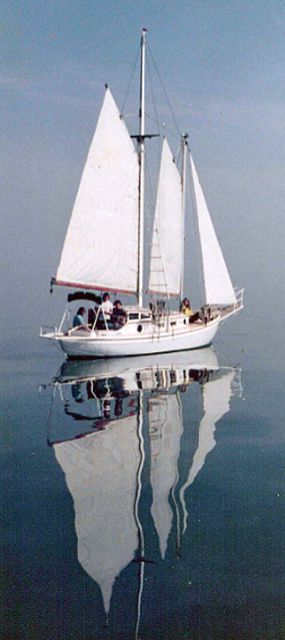
GAMBELLA Sublime
The next post will attempt to give a sense of what it took to transform the GAMBELLA from a derelict to the condition shown above.
Categories
- THE GALLERY
- Uncle Rob's Art
- 3D Works (stills) I
- 3D Works (stills) II
- 3D Works (stills) III
- 3D Works (video)
- Design & Abstract I
- Design & Abstract II
- Design & Abstract III
- Figurative Works I
- Figurative Works II
- Landscapes I
- Landscapes II
- Largest Art Project
- Nautical and Marine Images (video)
- Nautical and Marine Images I
- Nautical and Marine Images II
- Nautical and Marine Images III
- Nautical and Marine Images IV
- Portraits
- Still Life Images
- Stump Hollow Photo Essay I
- Stump Hollow Photo Essay II
- Uncle Rob's Mendocino Shop
- The Five Sense Series
- Irene's Creations
- Works by Don Mason
- Works by Don Mason II
- Works by Joseph de Borde
- Painting by Albert Robbins
- Art by Leslie Masters Villani
- Paintings by Nellie Harriet Parker
- The Art of Bee Yearian
- Works by Evie Wilson
- Uncle Rob's Art
- SCHOONER MOON BOOKS
- SEA STORIES
- ONE DOZEN AND TWO ESSAYS
- Cousinhood
- Art by Definition
- Cake Mixed Economy
- Marriage Anyone?
- Sex and/or Violence
- Searching for Truth
- The Philosophical Roots of Science
- Stepping Stones and Stumbling Blocks
- On Being Good
- Teaching By Example
- The Basic Law of Civilization
- Where Goeth Evil?
- A Modern Empircal "Religion"
- Knowledge as Wealth
- PAPERS AND ARTICLES
- FAMILY STORIES
- BOOK REVIEWS
Archive
- December 2021
- October 2020
- June 2020
- September 2019
- July 2017
- March 2017
- December 2016
- November 2016
- October 2016
- August 2016
- July 2016
- June 2016
- May 2016
- March 2016
- February 2016
- February 2015
- January 2015
- February 2014
- December 2013
- November 2013
- August 2013
- June 2013
- August 2012
- July 2012
- April 2012
- March 2012
- February 2012
- November 2011
- September 2011
- June 2011
- May 2011
- April 2011
- March 2011
- February 2011
- January 2011
- December 2010
- November 2010
- October 2010
- September 2010
- August 2010
- July 2010
- June 2010
- May 2010
- April 2010
- March 2010
- February 2010
- January 2010
- December 2009
- November 2009
- October 2009
- September 2009
- August 2009
- July 2009
- June 2009
- May 2009
- April 2009
- March 2009
- February 2009
- January 2009
- December 2008
- November 2008
- October 2008
- September 2008
